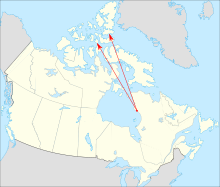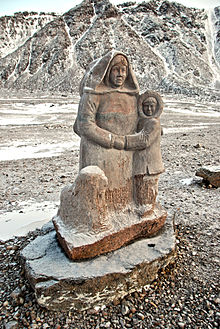You know that moment? That awkward moment when you're testing the bones of you latest suspected murder victim, and that victim happens to be more than 8,000 years old? Well coroner Floyd Johnson and archaeologist James Chatter found themselves in this exact situation in 1996.
On July 28, 1996 two hikers found a human skull by the Columbia river. They turned it over to the police, who turned it over to Floyd Johnson, the Benton country coroner. Suspecting that the skull had Native American connections, and knowing that the skull was very, very old, Johnson called in his archaeologist friend James Chatter. Chatter was able to excavate the rest of the body from the riverbank, and after sending a finger bone for analysis, they found out that the skeleton was more than 8,000 years old.
Here's where things get complicated. See, the land that the skull and skeleton were found on was being administered by the Army Corp of Engineers. The Corp of Engineers was in negotiations with local American Indian tribes over salmon fishing rights, and the Corp of Engineers were eager to appease the tribes, who demanded that the skeleton be handed over immediately for reburial.*
The tribes believed that Kennewick man was their distant ancestor, a belief proved by science in 2006. A body being buried, and remaining buried is an important part of Native American religion, which is why they wanted Kennewick Man returned for reburial.
As you might imagine, many scientists were more than a little dismayed, after all, how often do you come across an 8,000 year old skeleton? So, naturally, Smithsonian institute scientist Douglas Owsley, along with a few other scientists, decided to file a lawsuit against the US government.
What ensued was a 20 year legal battle over whether or not the skeleton could be studied. In the end the remains were given back to the Utilla tribe, and were reburied in February of 2017. Luckily for historians and scientists though, some research was done on the bones before they were reburied.
The findings of the analysis of Kennewick Man's skeletons completely changed the theories about how First Nation people ended up in North America. Previous theories said that First Nation people had most likely crossed on a land bridge between modern Russia and Alaska. Further studies confirmed that First Nation people could have sailed from the Japan area, keeping close to the shore to provide food for themselves. The sea-food rich diet that Kennewick Man ate adds strength to this theory.
You can learn a lot from bones, and a lot was learned from Kennewick man. There were tissue markers indicating that was right handed, and threw something (most likely a spear) quite frequently The markers suggest that he was throwing at a downward angle, suggesting that he was spear hunting for fish--a hypothesis his marine life diet certainly supports. There was further evidence suggestion that Kennewick man was very tough. He was in pain for most of his life, he had several ribs that broke, but never healed properly, there was a fracture in his shoulder, and he lived more than half of his life with a stone spear point embedded into his hip.
Kennewick man has been reburied, and it is unlikely that he will ever resurface, however scientists managed to glean enough information from him in their limited time of study to write a 680 page book about him. Their findings will continue to serve as an invaluable resource for archaeologists who study pre-history in North America.
*NAGPRA (Native American Grave Protection and Repatriation Act) is a law passed in 1990 that provides for the return of Native American remains and some artifacts to the tribes who own them. This was the law invoked by tribes concerning Kennewick man.
Sources
"Who Was Kennewick Man" by Reuben Flores, American Mosaic December 2015
Kennewick Man, The Ancient One
The Kennewick Man Finally Freed to Share His Secrets
 |
| Facial reconstruction of Kennewick Man |
Here's where things get complicated. See, the land that the skull and skeleton were found on was being administered by the Army Corp of Engineers. The Corp of Engineers was in negotiations with local American Indian tribes over salmon fishing rights, and the Corp of Engineers were eager to appease the tribes, who demanded that the skeleton be handed over immediately for reburial.*
The tribes believed that Kennewick man was their distant ancestor, a belief proved by science in 2006. A body being buried, and remaining buried is an important part of Native American religion, which is why they wanted Kennewick Man returned for reburial.
As you might imagine, many scientists were more than a little dismayed, after all, how often do you come across an 8,000 year old skeleton? So, naturally, Smithsonian institute scientist Douglas Owsley, along with a few other scientists, decided to file a lawsuit against the US government.
What ensued was a 20 year legal battle over whether or not the skeleton could be studied. In the end the remains were given back to the Utilla tribe, and were reburied in February of 2017. Luckily for historians and scientists though, some research was done on the bones before they were reburied.
The findings of the analysis of Kennewick Man's skeletons completely changed the theories about how First Nation people ended up in North America. Previous theories said that First Nation people had most likely crossed on a land bridge between modern Russia and Alaska. Further studies confirmed that First Nation people could have sailed from the Japan area, keeping close to the shore to provide food for themselves. The sea-food rich diet that Kennewick Man ate adds strength to this theory.
 |
| The skeleton |
Kennewick man has been reburied, and it is unlikely that he will ever resurface, however scientists managed to glean enough information from him in their limited time of study to write a 680 page book about him. Their findings will continue to serve as an invaluable resource for archaeologists who study pre-history in North America.
*NAGPRA (Native American Grave Protection and Repatriation Act) is a law passed in 1990 that provides for the return of Native American remains and some artifacts to the tribes who own them. This was the law invoked by tribes concerning Kennewick man.
Sources
"Who Was Kennewick Man" by Reuben Flores, American Mosaic December 2015
Kennewick Man, The Ancient One
The Kennewick Man Finally Freed to Share His Secrets



